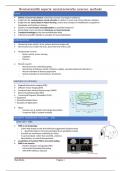Neuroscientific aspects: neural networks: neurosc. methods
GOALS
Deficits of neural recruitment underlying common neurological conditions;
Insight into the compensatory neural networks in relation to acute and chronic disease evolution;
Insight into the neural basis of motor learning, control and concepts of rehabilitation as applied to
hemiplegia and Parkinson’s disease
Evidence on non-invasive neurostimulation as potential rehab tool
Interpreting recent and relevant literature on neural networks
Translate knowledge to the neurorehabilitation field;
Critical and scientific attitude to concepts of neurorehabilitation.
INTRODUCTION
Measuring ‘brain activity’ at the systems level (not single-cell)
Non-invasive (not ‘inside’ the brain, but at the level of the scull)
Fundamental research
- Motor control, motor learning
- Cognition
- Memory
- ...
Clinical research
- Neural processes underlying ageing
- Neural basis of diseases (stroke, Parkinson, eplipsy, neurodevelopmental disorders..)
- Neural evaluation of disease progression
- Neural evaluation of interventions/ treatments
- …
OVERVIEW OF METHODS
Magnetic Resonance Imaging (MRI)
Diffusion Tensor Imaging (DTI)
Functional Near-infrared Spectroscopy (FNIRS)
Electro-EncephaloGraphy (EEG)
Transcranial Magnetic Stimulation (TMS)
=> Equipment
=> Neurophysiological basis
=> Examples of Applications
Figuur
- Concept voor & nadelen technologie beoordelen
- Temporele (tijd) & spatiale resolutie
MAGNETIC RESONANCE IMAGING – MRI
WHAT ISN’T FMRI
fMRI is not bumpology
- Claims that bumps on the skull reflected exaggerated functions/traits
Specifieke bulten in hersenen gerelateerd aan specifieke functies
- It lacked any mechanism underlying its claims.
- It used anecdotal, rather than scientific, evidence.
- Nevertheless, its central idea persisted:
Localization of Function fMRI is not mind-reading
fMRI is not invasive
- Positron Emission Tomography (PET)
- Intracranial Stimulation/Recording
- With fMRI nothing is injected!
Nala Melis Pagina 1
, Neuroscientific aspects: neural networks: neurosc. methods
WHAT IS (F)MRI
3 different modalities
- MRI = brain anatomy
- Functional MRI – fMRI = brain activity
- fc MRI = functional connectivity
BIOLOGICAL BASIS OF MRI
Measures brain anatomy
- Former name: (Nuclear) Magnetic Resonance Imaging
- Nothing to do with ‘radioactivity’, but with the magnetic properties of protons, in the nuclei of atoms
Protons :
- have a mass
- are positive (+)
- have a spin (they turn around)
because they turn around, they have a small, but measurable magnetic field
door spin= magnetisch veld= interactive met scanner
Protons are mostly found in water and fat tissue
In a single molecule of water, H2O there are 10 protons (1 from each hydrogen and 8 from oxygen)
E.g. a water cube of 2 x 2 x 5 mm contains
- 6 * 1015 protons
- 6.000.000.000.000.000
In everyday life, the protons in our body are in balance, randomly oriented, but in balance
- Not one specific direction per proton
Inside MRI scanner, which is one giant magnet, protons align to magnetic field (B0). Either in parallel (same
direction) or anti-parallel (opposite direction)
- Some in parallel or anti-parallel
Meeste in parallel alligneren= zelfde richting
majority of atoms aligns in parallel, allowing to define NET
magnetisation of protons in direction of B0
happens if you are positioned in scanner magnetic field = ALWAYS
on.
Proton is in ‘excitation state’ head coil “on”
Emission of a radio frequency pulse by the head coil, induces a flip of the NET magnetisation
(instead of aligning to the Z-axis, the protons now align in the X-Y field)
However, protons don’t like being in this ‘high-energy’ excitation state’, and from the moment
the radio frequency pulse is turned off, it will ‘relax’ to its initial position (i.e., align back to the
z-axis of the B0 field).
During ‘relaxation state’, protons emit radio frequency themselves, and this signal is measured.
Proton emits radio frequency during ‘relaxation state’
(the head coil, both emits and measures radio frequencies)
Nala Melis Pagina 2
, Neuroscientific aspects: neural networks: neurosc. methods
T1-relaxation= gemeten worden
- time it takes for a proton to relax to 63% of it’s initial state (along the z-
axis) is called T1
- KEY PART: the velocity from the proton aligning back to its initial
position is different for different types of tissue ‘relax’ the same way!
Not all tissue relax in the same way
Protons in fat (e.g. white matter), relax way faster, than protons in
liquid (e.g., cerebrospinal fluid)
- By measuring the relaxation in different tissues, contrasts can be
visualized!
- In so-called ‘T1-weighted’ images, liquid is dark (less energy emitted),
and fat is bright (more energy emitted)
- Vb afbeelding
Ventrikels= donkerder= ↓ RF
White matter= lichter= ↑R
Coronal slice Transverse slice Sagittal slice
MRI – EXAMPLE OF APPLICATION
Clinical: Localization of brain lesions
Pre-surgical mapping (e.g. epilepsy)
Prediction of disease progression
Long term motor function after neonatal stroke: Lesion localization above all
Prediction of disease progression – example of CP
Children tested at age 7
Some developed CP others didn’t
Lesions are more wide-spread in CP group, compared to group without CP symptoms
Example studie
Voorspellen ontwikkeling CP ivm. Andere die niet CP ontwikkelen
CP ontwikkelen groep= uitgesprokenere leasies
Afbeelding L
Unilateral CP
Afbeelding R
Zonder CP
Nala Melis Pagina 3




